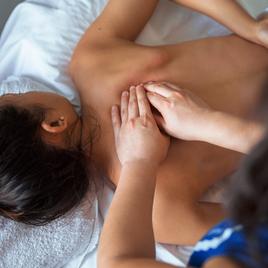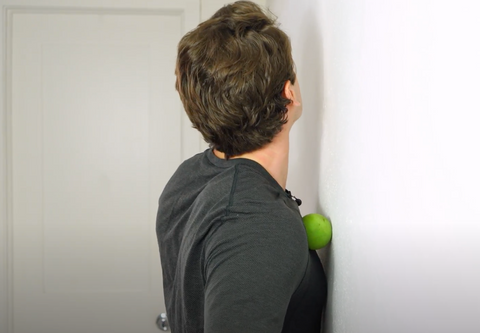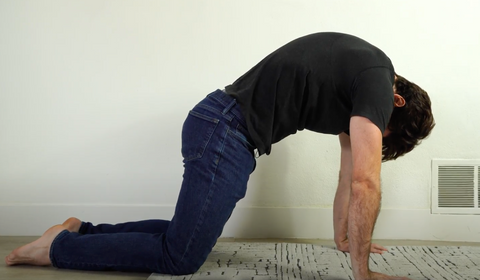Below is our effective method to help you untangle that irritating knot behind your shoulder blade! Relieve pain in a few simple steps while preventing future pain. Let's get rid of those annoying knots and embrace a life of comfort!

What Is A Knot?
Muscle knots are tight muscle fibers that can hold and accumulate tension, leading to pain, numbness, weakness, and tingling [1]. They can be the source of muscle discomfort as well as affect your range of motion and performance.
These knots, often called trigger points, can form as a result of overusing muscles, poor posture, stress, or damage. Given the complex relationships between shoulder muscle and scapula structure, knots frequently develop in the deeper layers behind the shoulder blade, which involves the rhomboids.
The Rhomboid muscle lies in the upper back beneath the lower trapezius and on top of the serratus posterior muscle. The Rhomboid connects from the spinal vertebrae directly to the shoulder blade in the back of the body.

Rhomboid Muscle & Pain Pattern [1]
How to Release Knot Behind Shoulder Blade
Start by targeting the underlying causes for a knot behind your shoulder blade by treating tight pectoral muscles. Tight pectorals can worsen the pain, and is essential to treating rhomboid knots properly.
Step 1: Pectoral Muscles Release
Start with the pectoral muscles by breaking any tight tissue. Use a lacrosse ball, muscle gun or massage tool for the best results.

Next for two minutes on each side, stretch the pectorals, focusing on extending to release the pressure on the rhomboids.
Step 2: Rhomboid Muscles Release
Muscle knots that contribute to upper back pain can be released by deep tissue massage.
To release tension behind the shoulder blade, massage the rhomboids for two to four minutes using a ball or a massage tool.
Find the area in the muscle that feels the tightest and begin applying pressure. (This may cause some discomfort at first, but the more elongated the affected tissue becomes, the easier it will be)
Once you find the area where the muscle is most tense, relax and allow your muscle to sink into the tool.
Try your best not to tense up and keep a steady breath—deep inhale-->slow exhale.


Step 3: Back Mobility Exercises
Below are 2 effective back exercises that will help prevent future knots behind your shoulder blade
Mid back twist:

Cat Camel:


How To Prevent A Knot Behind Your Shoulder Blade
Preventing muscle knots is just as important as treating them. The following techniques help prevent knots behind the shoulder blade from forming:
POSTURE! Hunching forward or slouching may feel comfortable in the moment, however, this puts major stress and tension on the muscles that surround your shoulder blades.
Include strength training: Enhancing the strength of the rhomboids, traps, and other surrounding shoulder/back muscles helps maintain good posture and lessen the likelihood of developing knots behind shoulder blade.

A few of these exercises include:
- Face pulls
- Rear delt raises
- Shoulder impingement exercises
- Row machine rows
- Barbell rows
- Pull-ups
- Incline rows
- Pike push-ups
Stay mobile, move around, and stretch regularly, especially if your job requires you to sit or stand for extended periods.
Stress reduction: Believe it or not, stress may aggravate tense muscles, especially in the upper back.
Benefits Of Deep Tissue Massage
In addition to being an effective technique for releasing knots behind the shoulder blade, deep tissue massage has many other benefits and is helpful to many other muscle groups:
Improved Circulation: Deep tissue massage promotes faster healing and muscular recovery by increasing blood flow to the muscles, which improves the supply of oxygen and nutrients and aids in the removal of toxins.
Increased Range of Motion: By focusing on the deeper layers of the muscle, deep tissue massage helps to release tension and limitations that restrict your movement. Try giving your rhomboids a deep tissue massage and feel how much more flexible your shoulders and upper back feel afterward.
Pain Relief: By easing muscle stress and tightness, deep tissue massage reduces chronic pain and offers much-needed relief from all sorts of bothersome knots and trigger points throughout the body.
Stress Reduction: Deep tissue massage provides significant relaxation and stress reduction in addition to its physical benefits.
Discover the full benefits of deep tissue massage by trying it out for yourself.
Choosing The Right Massage Tool
It can be difficult to choose which deep tissue massage tool works best for your specific problem. Foam rollers and lacrosse balls are great for surface area soreness and recovery. But, for more serious muscle tightness, they do not have the same effect as the physical touch of a medical professional's knuckle or elbow.
That's why we designed the QL Claw. We wanted a proper tool that could replicate the physical touch of a professional while being designed for the all the pain inflicting muscles (QL, glute medius, psoas, TFL, rhomboid).
Knot Behind Shoulder Blade - FAQ
How long until shoulder knots go away?
There is no set time. Knots have the potential to stick around for a while, especially when left untreated. Fortunately, there are things you can do to speed up the process such as deep tissue massage and targeted stretching.
Can stress cause shoulder blade knots?
Yes, when muscles are held in a tense state for an extended period of time, knots can form.
Is a muscle knot and trigger point the same thing?
Yes, a knot and trigger point are both different terms for compact and injured muscle tissue.
What does a knot feel like?
Feels as though there is an area of stiffness or tension in the muscle. Pressing on a knot may cause pain or discomfort, which occasionally spreads to other parts of the body. In general, a knot is felt as a localized spot of tight muscles that can be uncomfortable and get in the way of your everyday tasks.
Sources:
[1] Donnelly, Joseph M. Travell, Simons & Simons Myofascial Pain and Dysfunction: the Trigger Point Manual. 3rd ed., Wolters Kluwer Health, 2019.
[2] Davies, Clair, and Amber Davies. The Trigger Point Therapy Workbook: Your Self-Treatment Guide for Pain Relief. 3rd ed., New Harbinger Publications, Inc., 2013.


